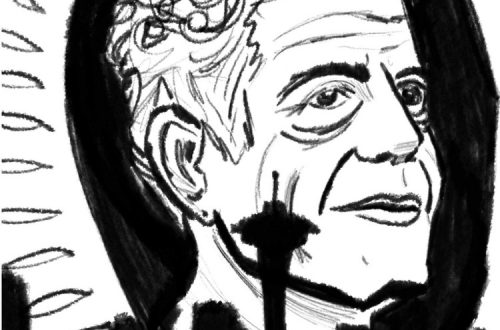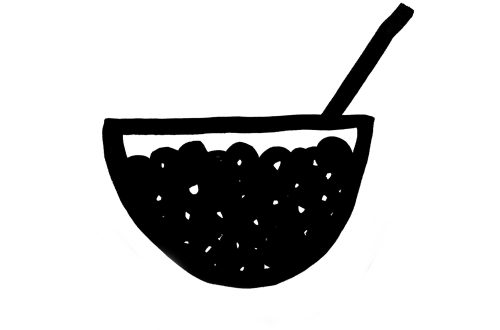by Jonathan Ammons
“Miami – Part Two” aired on Season 2, Episode 1 of the Dirty Spoon Radio Hour on May 3, 2019.
The following is part two of a multi-chapter series. To catch up on Chapter one, click here.
Wide awake at six a.m. From the porch of our treehouse, you can watch the sunrise and see the entire farm crawl back to life. A rooster has been hoarsely and incessantly crowing since 4:30 this morning. Chickens peck for feed and fluff their feathers at one another while turkeys, perched atop the roofs of their pens, ring out a call that sounds like tearing paper.
The goats stand huddled together, staring vacantly into the distance.
Do goats sleep standing up? Because about now it looks as though they do.
The hogs are already nose-deep in slop, and an emu peeks through the slats of the wooden fence at me, his head bobbing too and fro in curiosity. The cats, of which we’d already noticed a handful, are also being fed. I hadn’t realized how many there were until they are all here at once, perched on every railing and bench on the farm’s campus, devouring breakfast. Everything, literally everything here, is moving.
Earth ‘N Us Farm feels worlds away from the hustle and bustle of the city outside its walls. Just off 79th street and a stone’s throw away from the bustle of North Miami Avenue, the farm has become a fixture in the community of Little Haiti. Since 1978 Ray Chasser has been developing an urban permaculture farm in the heart of what was once considered a very rough neighborhood, and where he and his delightful wife Leslie were kind enough to rent us a room in their three-story tree house.
According to a 2005 study by the Brookings Institute, there are over 95,000 Haitians living in Miami. Over a third of them earn under $18,000 per year. But there’s good reason for the stark line of poverty among Haitians as compared to the Cuban neighborhoods.
In the 1950’s, Francois “Papa Doc” Duvalier rose to power as the nation’s democratically elected President-turned-maniacal-dictator. When you think stereotypical “crazy dictator,” Papa Doc pretty much wrote the book. After enduring partial brain damage during a heart attack, Duvalier, who had been elected as a hero after working tirelessly in the medical field to help eradicate several major epidemics of contagious diseases, began to become increasingly paranoid and neurotic. Reviving centuries old Voodoo traditions, he declared himself the embodiment of the Haitian spirit Loa, and even began dressing the part. He wore dark glasses to shield his eyes and yelled in a high-pitched, almost cartoonish voice to imitate the deity. Through the organization of his secret police, the Tonton Macoute, Papa Doc murdered upwards of 60,000 Haitians and drove thousands more into exile.
In the beginning, in the 50’s and 60’s, many of those in flight were affluent, and turned their wings towards New York. But in the 80’s, at the height of the Duvalier Family’s terror (his son succeeded him in 1971), the nation’s poorest began to flee, spilling off the island like ants from a trampled nest. The “Haitian Boat People,” as the papers soon termed them, came in with the waves off the coast of Florida. Thousands of families crammed into tiny boats, with far too many sinking while attempting to cross the rough waters. In fact, according to the 2012 US Census, 514,000 Haitians have made their way to the United States since 1980 alone.
Where do they all go?
Most of them come here, to a neighborhood between the Florida East Coast Railways and Interstate 95, a neighborhood once known as Lemon City.
In 1972, the first boat of Haitian Refugees would land in Miami. That was just one year before Viter Juste — a once prominent businessman in Haiti, forced into exile in the 50’s — would leave New York for the warmer climates of Lemon City. It was Juste who saw the natural assemblage of Haitians in the neighborhood and began working to organize the area. One day, the headline of an editorial penned by Juste that coined the term: “Little Haiti.”
His cultural revolution in Miami began with a record store. “Les Cousins” began as a way to get Haitian music to those a little homesick for the sounds they remembered from just across the pond.
From there, it expanded to a bookstore stocking French and Creole language authors. From there, he generated Miami’s first French language newspaper, a $0.25, 12-page weekly rag, and taught English classes in the evenings, helping immigrant families adjust to the new culture. Through his connections with the Catholic Church, Juste and his fellow Little Haitians helped to build a home for thousands of refugees tossed to the sea by a maniacal dictator and his appointed ruling son.
It is important to point out that the days of mass immigration from Haiti directly overlapped with much of the waves of refugees leaving Cuba, but these two groups were treated drastically differently.
When the mass immigration of the Mariel began in April of 1980, it was almost possible to get those crowded boats confused with those filled with the Haitian Boat People of that same year. 125,000 Cubans and 80,000 Haitians braved that risky passage. In direct response to the waves of immigration, President Jimmy Carter created the Cuban/Haitian entrant (status pending) category of classification, allowing refugees to quickly and safely situate themselves into the States and work out all the kinks later.
In 1981, however, President Reagan decided to take a different approach. He ordered the Coast Guard to return any Haitian boat seized in the waters between the Island nation and Florida. Only twenty-eight of 25,000 Haitian applications for asylum were granted during his administration compared to 10,000 Cuban application approvals. The situation become increasingly worse over the following administrations.
In 1992, over 10,000 Haitians attempted another mass migration, all turned away by President Bill Clinton. Through his presidency, George W. Bush managed the relocation of an additional 37,000 Haitian migrants that followed over the years to the US maintained prison at Guantanamo Bay. Despite the death tolls, Bush insisted that there was “no record of human rights abuse” in Haiti, and that the US could therefore not accept migrants from the nation.
From the plain metal chairs and white tile floors of Chez le Bebe on on NE 54th St, you see a glimpse of this other side of Miami. A slightly inebriated door man in a ripped hoodie sweatshirt and cut-off gloves dramatically gestures us into the sparse eatery, mumbling something in Creole. It looks as though everyone arrived here by themselves. Most are waiting for carryout, and after being quietly and ominously observed by everyone in the joint, Suzi decides to do the same.
There’s no music, only the sound of a TV droning around the corner. It’s early, but it is still dark. Outside, a police cruiser slowly crawls by with his spotlight combing through the recesses and alleyways. Inside, there’s a line formed in front of the counter. It’s a simple, humble space, with a menu hung on the wall, mostly consisting of a meat, rice and beans, plantains and a salad.
Opened in 1984, Chez le Bebe has become a staple of Haitian Cuisine in the neighborhood. Chef Delia Jean has been behind the grill for decades slinging good, cheap food. Griot is the staple around here: scotch bonnet fried chunks of pork with the bone still in, allowing that marrow to stew with the meat. There’s a spicy slaw and a red sauce that packs a punch on the side. Judging from the cheap prices, we order a lot. Fried turkey and griot with sides. When our order comes, we are shocked to find massive boxes packed to the gills, pounds and pounds of food for under $20.
As we get up to leave, a young man in a white sweater beckons me to his table.
“I am a mystic!” he exclaims in a thick accent. “Let me show you!”
I look at Suzi, who is standing outside being heckled by the doorman. I move toward her. Another man stands on the corner and watches both of us from a distance. It is clear that it is we who are out of place here, the strangers in a land that may as well be another country.
“I open the door for you, now grease me,” mumbles the doorman. I pull a crinkled dollar from my pocket and stuff it in his palm. “You’re a good man,” he slurs before drifting back into a blend of French and Creole. On the short walk back to the car, another police car passes, its spotlight drifting across the sidewalks.
While I was warned by multiple locals before my trip that Little Haiti was a rough area, it is important to point out that the neighborhood, while still holding one of the highest crime rates in Miami, is drastically changing. And while some of that change is coming from gentrification, much of it is coming from within. Neighbors and long-time residents continuously improve on a community of great pride, and much history. You see it in the beautiful murals on the stores, by the kind people on every corner, and by the remarkably kept nature of each borough and neighborhood.
Back at the farm, we sit down in the outdoor kitchen hut. We open the boxes of food. The griot and turkey are unbelievably flavorful and tender, with little crispy hints of char around the corners. The beans and rice are generously seasoned, and the plantains lend a sweet repose from the onslaught of savory fats.
A white cat riddled with mange spots us and decides to join us for our feast, ostentatiously poking its nose directly into our dinner. Suzi deftly adopts a protective stance, wrapping an arm around a box to elbow out the prying feline, and it becomes a constant act of nudging its whiskers out of the box, taking a bite, and boxing out the feline again. Relentless. Absolutely relentless.
Eventually we start leaving tiny pieces of pork at the edge of the counter to lure it away, but that only proves to strengthen the little bastard’s resolve. This goes on for the entirety of dinner. “I hope this cat doesn’t die from pork intake!” I say. “I’m pretty sure these people are vegan.”
It’s only 8pm, but the farm is silent. The chickens already asleep in their coop, the pigs all cuddled together, alternating nose to tail. One of them is even snoring, his fat jowls flapping with each huff and puff.
When Ray purchased this land to build his farm in 1978, he paid $35,000 for a quarter-acre portion. He pieced it together buying another quarter-acre each year until 1986 when he’d successfully acquired two acres and half of a city block. “It was the gumbo limbos here that sold me,” he once told the Biscayne Times. At night, in the breeze, you can hear their leaves rustle in the arms of the massive branches that canopy above the farm.
During the day, Earth ‘n Us is open to the public. They often host field trips, drum circles, and potluck dinners. They’ve held fire walks and concerts, and they teach school children about the wonders of medicinal herbs and how to identify them. Often in urban environments it becomes crucial to connect children back to the roots of where their food originates. When you’re surrounded by enough concrete and cinder blocks, fruit begins to seem like something that comes out of a refrigerator, not the branches of a tree, and meat can start to seem like it was always encased in plastic wrap. To see the little piggies, to pet the goats: it lends a little perspective on where that griot actually came from.
After dinner, back in our cozy tree house, Suzi and I are finishing off a bottle of wine when I decide to put on a Talking Heads song, the noodling synth line of which has been running through my head since I landed in Florida.
Home is where I want to be, Pick me up and turn me around. I feel numb, I burn with a weak heart, I Guess I must be having fun.
Spend enough time on the road and you develop a strange sense of homesickness that breeds in you even when you are sitting on your own front porch. A longing for places you’ve not seen in years, or perhaps only briefly encountered. As Suzi drifts off to sleep and I slip out onto the porch to sit in a light breeze rustling through the palms, the lyrics still reverberate in my head.
Home, is where I want to be but I guess I’m already there. I come home, she lifted up her wings, I guess that this must be the place. I can’t tell one from the other, did I find you, or you find me? There was a time before we were born. If someone asks, this is where I’ll be.
There are places that immediately feel right, corners that just simply fit. And there, with the salt breeze in the air, the vague scent of chicken shit, the shanty shacks, tree houses, and cabins glowing in the lamp light, it feels like home. I can hear Suzi breathing inside, I can hear pigs snoring, crickets, and the distant lull of traffic, and I think to myself, this must be the place.
Our exploration of Miami continues in chapter 3, here.






